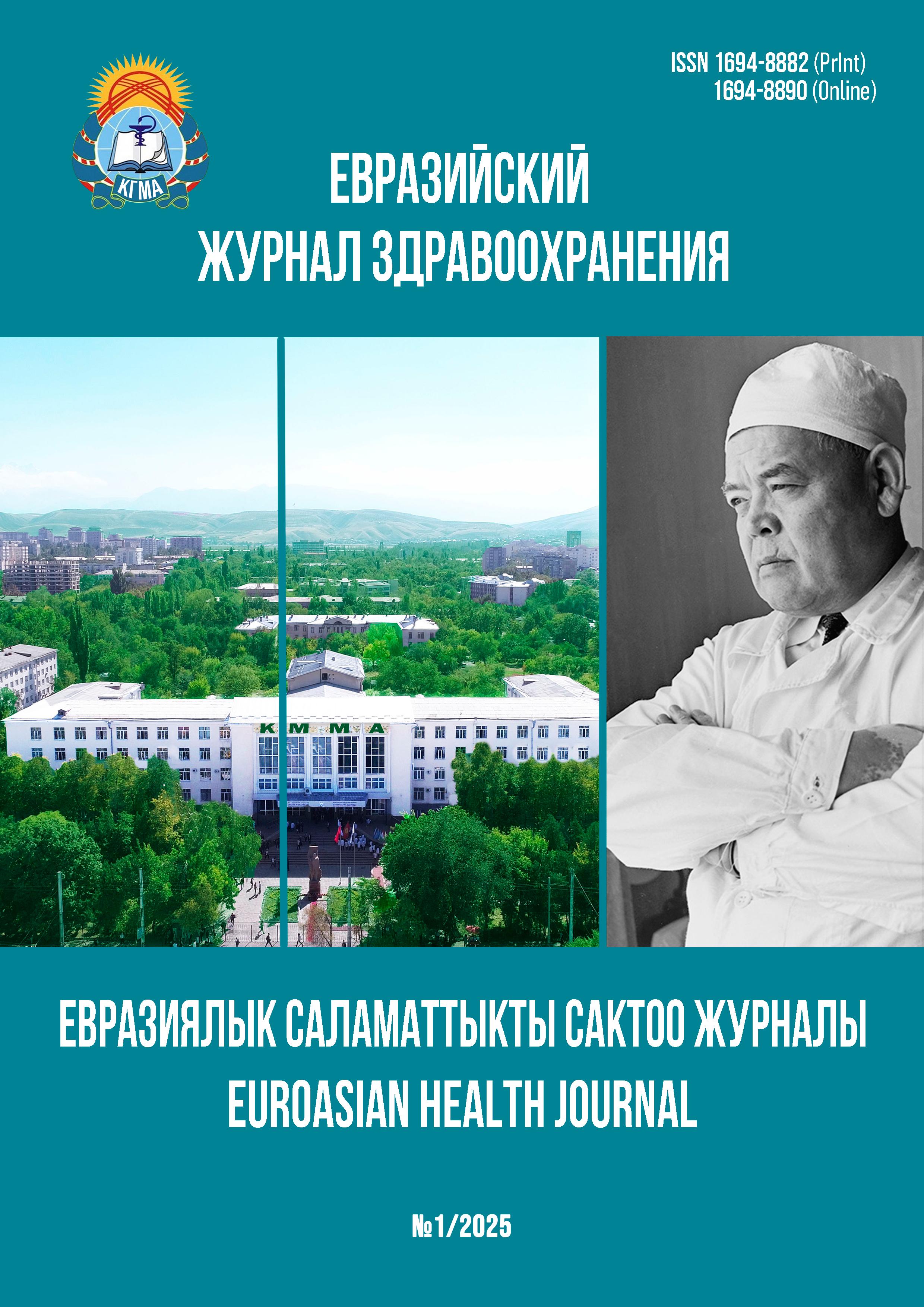INCIDENCE OF MENINGOCOCCAL INFECTION BY AGE ASPECT BY REGIONS OF THE KYRGYZ REPUBLIC, 2014-2024
DOI:
https://doi.org/10.54890/1694-8882-2025-1-235Abstract
The article presents the results of the epidemiological analysis of the incidence of meningococcal infection in the age aspect in the regions of the Kyrgyz Republic for 2014-2024.
An analysis of the long-term dynamics of the incidence of meningococcal infection over the past 10 years showed that the highest levels were recorded in the period 2014-2016 and 2023. In the republic, during the years of the COVID-19 pandemic, the incidence of meningococcal infection was recorded only in Bishkek and Osh region. The cumulative country rate for the analyzed period was 38 cases per 100,000 population (0/0000); the most susceptible were children under 14 years of age (1600/0000), adolescents were twice as ill (76,50/0000); there was also involvement of persons over 18 years of age (23,10/0000). High morbidity was recorded in the cities of Bishkek (59,00/0000), Osh (38,20/0000) and Chui region (14,90/0000). In such regions as Talas (6,60/0000), Batken (6,50/0000), Naryn (6,30/0000) and Osh (5,80/0000) the initiation rate was almost at the same level. In Issyk-Kul (2,70/0000) and Jalal-Abad (2,70/0000) regions the intensive indicators were relatively low.
Thus, in the Kyrgyz Republic for 2014-2024, cyclical increases in meningococcal infection were observed in the period 2014-2016 and 2023, while the interepidemic period was 8 years. If we take into account the cyclical nature of the increase in meningococcal infection every 8-15 years, then the gradual increase in the incidence rate from 2022 may be the beginning of a new outbreak of meningococcal infection in the republic, which requires strengthening preventive and anti-epidemic measures in the country. The high incidence of the disease in large cities, with the highest incidence among children and adolescents, requires explanatory work with parents through the media to avoid mass events in closed spaces and to recommend vaccination at the expense of the population.
Keywords:
meningococcal infection, epidemiology, morbidity, children, adolescents, adults, regions, Kyrgyz RepublicReferences
1. World Health Organization. Defeating meningitis by 2030: a global road map. WHO; 2021. 22 c. Available from: https://www.who.int/publications/i/item/978924002640
2. Mustapha MM, Marsh JW, Harrison LH. Global epidemiology of capsular group W meningococcal disease (1970-2015): Multifocal emergence and persistence of hypervirulent sequence type (ST)-11 clonal complex. Vaccine. 2016;34(13):1515-1523. http://doi.org/10.1016/j.vaccine.2016.02.014
3. Acevedo R, Bai X, Borrow R, Caugant DA, Carlos J, Ceyhan M, et al. The Global Meningococcal Initiative meeting on prevention of meningococcal disease worldwide: Epidemiology, surveillance, hypervirulent strains, antibiotic resistance and high-risk populations. Expert review of vaccines. 2019;18(1):15–30. https://doi.org/10.1080/14760584.2019.1557520
4. Wunrow, HY, Bender, RG, Vongpradith, A, Sirota SB, Swetschinski LR, Novotney A, et al. Global, regional, and national burden of meningitis and its aetiologies, 1990–2019: a systematic analysis for the Global Burden of Disease Study 2019. The Lancet Neurology. 2023;22(8):685–711. https://doi.org/10.1016/S1474-4422(23)00195-3
5. The Lancet. A new roadmap for meningitis. Lancet. 2020;395(10232):1230. https://doi.org/10.1016/S0140-6736(20)30865-5
6. Всемирная организация здравоохранения. Глобальная программа «Победить менингит к 2030 году». Доступно: https://www.who. int/initiatives/defeating-meningitis-by-2030.
7. Королева M.A., Грицай М.И., Миронов К.О., Ярыгина Е.А., Валдохин А.В., Янушевич Ю.Г. и др. Эпидемиологические проявления вспышки менингококковой инфекции, обусловленной Neisseria meningitidis серогруппы А, в Новосибирске в 2019 г. Эпидемиология и инфекционные болезни. Актуальные вопросы. 2021;11(2):13-21. https://doi.org/10.18565/epidem.2021.11.2.13-21
8. Лобзин Ю.В., Скрипченко Н.В., Маркова К.В., ГореликЕ.Ю., Вильниц А.А., Пульман Н.Ф. и др. Семейные случаи менингококковой инфекции, вызванной Neisseria meningitidis серогруппы W. Педиатрия. Журнал им. Г.Н. Сперанского. 2019;98(1):242–245. https://doi.org/10.24110/0031-403X-2019-98-1-242-245
9. Центр электронного здравоохранения при МЗ КР. https://cez.med.kg/
10. Береговой З.К., Джолбунова З.К., Кадырова Р.М. Клинико-эпидемиологические особенности течения острых бактериальных менингитов в различных возрастных группах. Бюллетень науки и практики. 2019;5(11):104-114. https://doi.org/10.33619/2414-2948/48/14
11. Кайкиева М.Б., Уралиева М.К., Рыскулбекова А.Б., Кундашев К.У., Ногойбаева К.А. Эпидемиологическая характеристика бактериального менингита в г. Бишкек за 2022-2023 гг. Евразийский журнал здравоохранения. 2024;1:89-94. https://doi.org/10.54890/EHJ-2024-1-89
12. Национальный статистический комитет КР. Население. https://stat.gov.kg/ru/statistics/naselenie







